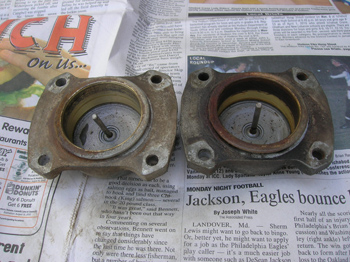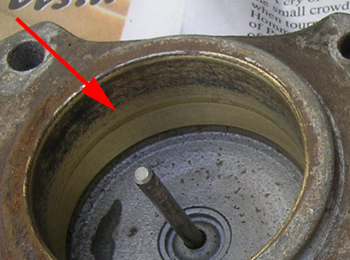Hubs and Brakes
4/24/10
Hubs and Brakes

Looking at my rear hubs after returning from Florida, I noticed the rear seals were leaking again. I replaced these seals before, and I needed to take a closer look. I inspected the the hub very closely, trying to find the source of the leak. Besides the seal, there are several other places differential oil can leak, but the source was still from the seal. 
I decided to disassemble the hub and try cleaning and polishing the sealing surface of the hub. There was a slight groove where the seal touches the hub assembly, so after chucking the hub on my lathe, I polished the area with a “scotch bright” pad. 
The last time I drove the car, I noticed a sticking rear caliper, so since I had the brake fluid drained from the system, I decided to take a closer look. Brake calipers can be re-sleeved in either brass or stainless steel. I had all my calipers re-sleeved by a re builder Francois was using several years ago in brass. I was surprised to find a lot of corrosion on the exposed portion of the brass sleeve. The piston on the right was the untouched corroded piston, while the one on the left is one that I cleaned with some light sand paper. Even with the rubber boot intact, the bores managed to corrode pretty badly.
On the sticking caliper, I found a groove that was probably the reason for the faulty piston. I tried cleaning up the bores, but I think there was too much corrosion for the seal to work. What’s also interesting is the heaviest corrosion is in an area that is not immersed in brake fluid since Dunlop brakes have the seals on the piston. As the brake pads wear, the seal moves further out on the bore, dragging the seal across the corroded bore.
I called Karps Brake Service, and they said they could probably cut out the brass bore and insert their stainlesss steel sleeve. It’ll be interesting to see how well the stainless steel bores last compared to the brass bores.
Previous Restoration Day
Next Restoration Day
Home page




